Book contents
- Frontmatter
- Contents
- Contributors
- Preface
- Introduction
- 1 The Early and the Imperial Kingdom in Southeast Asian History
- 2 Hydraulic Works and South East Asian Polities
- 3 Some Notes on Relations between Central and Local Government in Ancient Java
- 4 Negara, Mandala, and Despotic State: Images of Early Java
- 5 Some Remarks on Early State Formation in Cambodia
- 6 “Elephants Can Actually Swim”: Contemporary Chinese Views of Late Ly Dai Viet
- 7 Authority and Legitimacy in 11th Century Vietnam
- 8 From Myth to History: Imagined Polities in 14th Century Vietnam
- 9 Shipshape Societies: Boat Symbolism and Political Systems in Insular Southeast Asia
- 10 Changing Perspectives in Island Southeast Asia
- 11 Political and Cultural Continuities at Dvaravati Sites
- 12 The True and the Corbel Arch in Mainland Southeast Asian Monumental Architecture
- 13 Vietnamese Ceramics and Cultural Identity: Evidence from the Ly and Tran Dynasties
- 14 Traditions, Acculturation, Renovation: The Evolutional Pattern of Vietnamese Culture
- 15 Symbolism of Kingship in Arakan
- 16 Buddhism in Champa
- 17 The Ordering of Generations: Change and Continuity in Old Javanese Kinship
- 18 Sources on Economic Activities in Khmer and Cham Lands
- 19 Narrative Bas-Reliefs at Candi Surawana
- 20 Possibilities for a Reading of the 1293-1357 Period in the Vietnamese Annals
- Index
- Miscellaneous Endmatter
7 - Authority and Legitimacy in 11th Century Vietnam
Published online by Cambridge University Press: 21 October 2015
- Frontmatter
- Contents
- Contributors
- Preface
- Introduction
- 1 The Early and the Imperial Kingdom in Southeast Asian History
- 2 Hydraulic Works and South East Asian Polities
- 3 Some Notes on Relations between Central and Local Government in Ancient Java
- 4 Negara, Mandala, and Despotic State: Images of Early Java
- 5 Some Remarks on Early State Formation in Cambodia
- 6 “Elephants Can Actually Swim”: Contemporary Chinese Views of Late Ly Dai Viet
- 7 Authority and Legitimacy in 11th Century Vietnam
- 8 From Myth to History: Imagined Polities in 14th Century Vietnam
- 9 Shipshape Societies: Boat Symbolism and Political Systems in Insular Southeast Asia
- 10 Changing Perspectives in Island Southeast Asia
- 11 Political and Cultural Continuities at Dvaravati Sites
- 12 The True and the Corbel Arch in Mainland Southeast Asian Monumental Architecture
- 13 Vietnamese Ceramics and Cultural Identity: Evidence from the Ly and Tran Dynasties
- 14 Traditions, Acculturation, Renovation: The Evolutional Pattern of Vietnamese Culture
- 15 Symbolism of Kingship in Arakan
- 16 Buddhism in Champa
- 17 The Ordering of Generations: Change and Continuity in Old Javanese Kinship
- 18 Sources on Economic Activities in Khmer and Cham Lands
- 19 Narrative Bas-Reliefs at Candi Surawana
- 20 Possibilities for a Reading of the 1293-1357 Period in the Vietnamese Annals
- Index
- Miscellaneous Endmatter
Summary
An approach to the Lý dynasty
The conventional view of the Lý dynasty has been that it established a centralized state power in Vietnam during the course of the eleventh century. Whether arguing from the historical, bureaucratic model of a strong Chinese dynasty[1] or the theoretical, economic model of the Asiatic Mode of Production,[2] scholars in and out of Vietnam have favoured the idea that, beginning with the Lý, dynastic power in Vietnam was expressed as a centralized state that wielded effective administrative control over the different territories of the realm.
This view has in recent years been questioned by two Japanese scholars. Minoru Katakura, who has surveyed legal codes and their application in Vietnam during different historical eras, did not directly challenge the idea of a centralized political power, but he introduced fresh insights that stimulate doubt. In 1973, he used the term “centralized feudal system”[3] he believed that the distinctive characteristics of the Lý penal code (its relative “tolerance” or leniency) was related to “the power structure of the dynasty”, and “the political power basis of the Lý dynasty was founded on its acceptance of the traditions and the independence of villages”.[4] In 1977, he noted that the court chronicles record frequent appearances of dragons during the Lý dynasty and that the Lý kings often presided over traditional religious rites such as oaths and covenants or prayers for rain; he went on to surmise that the Ly family tried to establish imperialistic rule over rival clans by transforming traditional Vietnamese customs into national religious rites.[5] Yumio Sakurai interpreted Katakura's view of the Lý dynasty as a shamanistic, religious dynasty rather than a state based on laws.[6]
In 1980, Yumio Sakurai published his study on patterns of settlement and agriculture during the Lý dynasty, one in a series covering several epochs of Vietnamese history.[7] He based his work on a thorough search of historical sources and a detailed knowledge of premodern agrarian economy. He argues that the Lý dynasty was a “local dynasty”, meaning that it directly controlled only one of several political-economic regions in the plains of northern Vietnam.[8] He believes that the different regional powers that appeared during the tenth century were not completely suppressed until the thirteenth century by the Tran dynasty.
- Type
- Chapter
- Information
- Southeast Asia in the 9th to 14th Centuries , pp. 139 - 176Publisher: ISEAS–Yusof Ishak InstitutePrint publication year: 1986



